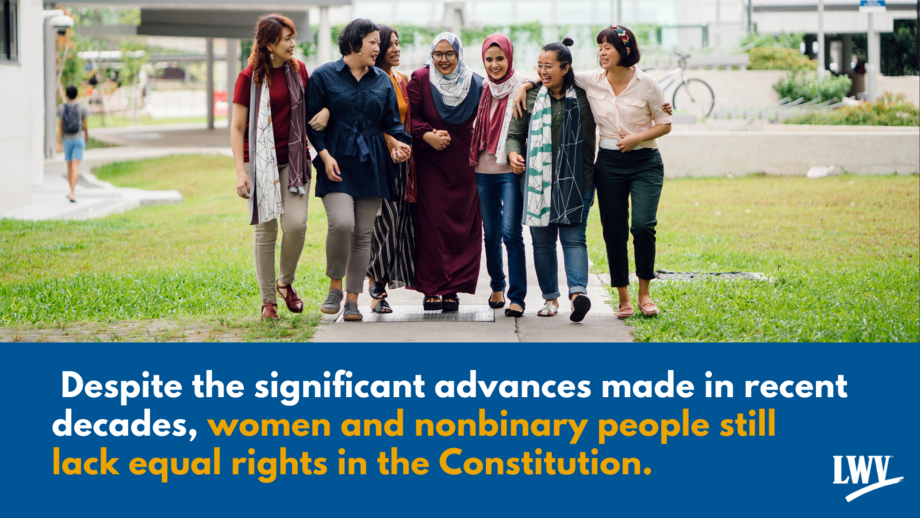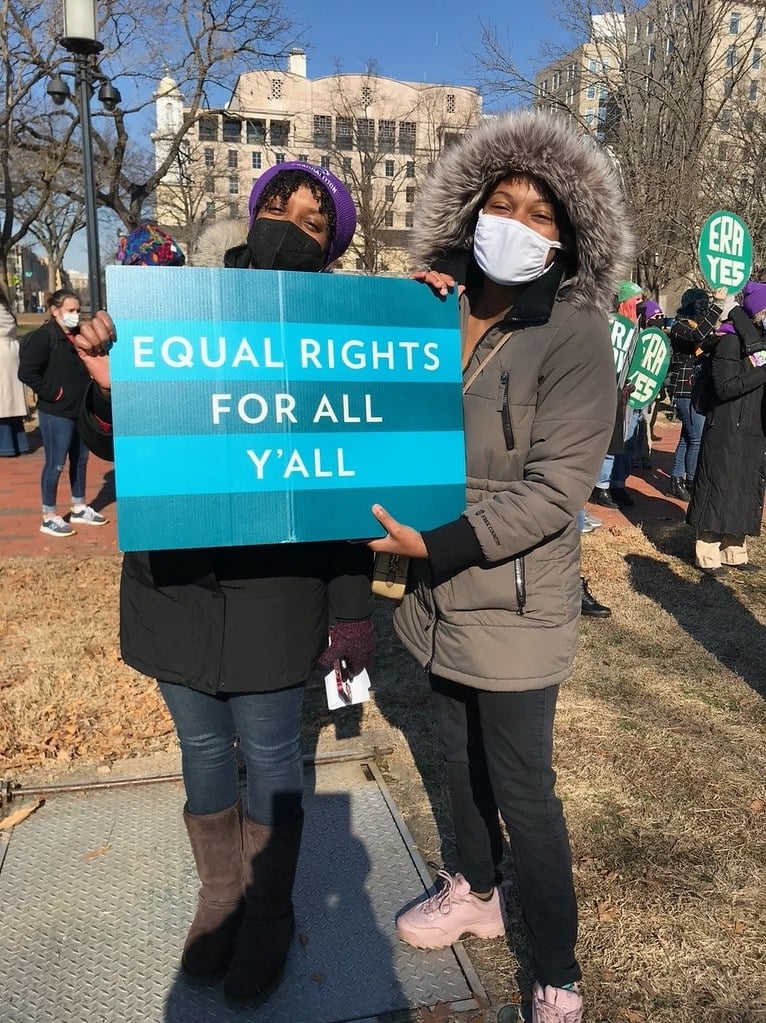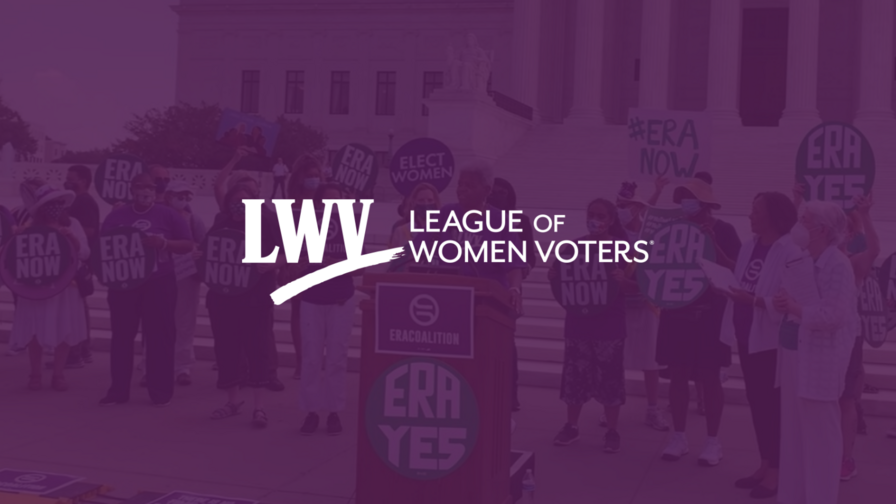100 Years of the Equal Rights Amendment
2023 marks the 100th anniversary of the Equal Rights Amendment (ERA).
The ERA has a long history of champions who aimed to achieve “equality of rights under the law” for people of all sexes in our Constitution. In honor of its 100th anniversary, we offer a look back at their work, how the ERA progressed, and where we are in the fight for equality.
Tell Your Representatives to Support the ERA
The Alice Paul Amendment
In 1923, just three years after the 19th Amendment was ratified, Alice Paul began her post-suffrage crusade of ensuring that men and women had equal rights throughout the United States. Refusing to leave activism behind, she continued the movement for equality after many well-known suffragists left public life. She got the ERA introduced into Congress the same year she announced it.
Paul was a tireless advocate for equality. In the 1930s, she moved abroad and formed the World Woman’s Party, which fought for the inclusion of gender equality in the UN Charter. The WWP also fought to establish the UN Commission on the Status of Women. In the US, her proposed ERA enjoyed bipartisan support from the Republican and Democratic parties when it was added to the party platforms in the 1940s. It was introduced in every single Congress, but it wasn’t until a new champion came along that it made it to the floor of the House and Senate.
Martha Wright Griffiths: Mother of the ERA
In 1955, Representative Martha Wright Griffiths (D-MI) was elected to Congress and began introducing the ERA in every session of Congress. Still, it never managed to get out of the Judiciary Committee.
In 1970, she used a discharge petition, which required a majority of signatures (218), to move the bill from a committee to the floor of the US House for consideration. Griffiths successfully gathered the necessary signatures in 1970 by personally asking members, calling in favors, and following up with reluctant male members of Congress until she persuaded them to add their names to the petition.
When the bill came to the floor, Griffiths said, “Mr. Speaker, this is not a battle between the sexes—nor a battle between this body and women. This is a battle with the Supreme Court of the United States.” The debate was successful, and the US House passed the bill. Still, the Senate offered an amendment that exempted women from the draft, and a conference committee could not find common ground before the end of that session of Congress.

Griffiths tried again in 1972, and that’s when the hard work of Griffiths and her female colleagues, including Shirley Chisolm (D-NY) and Margaret Heckler (R-MA), finally got the amendment approved by the House in 1971. The Senate offered final approval in 1972.
The ERA’s Seven-Year Ratification Deadline
After Congress finally passed the amendment with the required votes, it headed to the states for ratification. The catch was that Congress attached a seven-year timeline for ratification by the required 38 states.
The idea of time limits on constitutional amendments is a modern congressional addition to the amendment ratification process. Before the twentieth century, there was no discussion of imposing a time constraint on the state’s consideration of a proposed amendment. Congress derives its power to set a time limit from its authority to designate a mode of ratification.
Thirty states ratified the amendment in the first year, but then momentum slowed. Congress extended the ratification timeline for three more years, but by the time the deadline expired in 1982, only 35 states had ratified it, leaving it three short of the needed states.
In 2013, the National Archives called the ERA “the most popular never-ratified amendment.” At the time, the ERA made up ten percent of all the amendments ever proposed to the Constitution, but it never made it into the Constitution. Even now, public opinion still favors final ratification and publication, with 3 of 4 Americans supporting the ERA.

The final three states ratified the ERA beginning in 2018, when Illinois and Nevada propelled successful legislative initiatives toward the finish line, putting the ERA one state away from achieving the 38-state threshold for ratification. In 2020, Virginia became the final state needed to ratify the ERA. Even with the required supporting the ERA, ratification remains elusive because of the seven-year deadline. In 2020, following final ratification by Virginia, the Justice Department Office of Legal Counsel under the Trump Administration published a memo on whether the ERA could be published in the Constitution. The memo was in response to a request from the National Archives, which oversees the final publication of all constitutional Amendments. The 2020 memo read:
"We conclude that Congress had the constitutional authority to impose a deadline on the ratification of the ERA. Because that deadline has expired, the ERA Resolution is no longer pending before the States."
Advocates were hopeful that after President Biden took office, the new administration would reverse the opinion and instruct the National Archives to publish the amendment. But the Biden Administration left the opinion in place and offered clarification on the role that Congress plays in ratification stating in a 2022 memo:
"A 2020 opinion of the Office of Legal Counsel that addressed the legal status of the proposed Equal Rights Amendment is not an obstacle to Congress’s ability to act concerning ratification of the ERA or to judicial consideration of questions regarding the constitutional status of the ERA."
In other words, the Biden Administration is throwing the final decision back to Congress to clarify. Case law has established that Congress has a clear basis for its authority to extend or remove the time limit from the resolving clause of the Equal Right Amendment. The idea of time limits on constitutional amendments is a modern congressional addition to the amendment ratification process. Before the twentieth century, there was no discussion of imposing a time constraint on the state’s consideration of a proposed amendment. Congress derives its power to set a time limit from its authority to designate a mode of ratification.
A legislative solution to clarify the timeline issue and affirm that the ERA is indeed ratified has been introduced in Congress. In the 117th Congress, the legislation was passed by the US House but failed to receive a vote or committee consideration in the Senate. On February 28, 2023, the US Senate held its first hearing in 40 years on the ERA. The hearing in the Senate Judiciary Committee heard from advocates about why the ERA was needed and legal scholars with differing views on the path forward for the amendment. One of the witnesses, Thursday Williams, a board member for the ERA Coalition, offered an impassioned plea for final ratification, saying:
"The Equal Rights Amendment has fulfilled all requirements to be added to the Constitution, now it’s time for it to be recognized. If we continue to hold back more than half of our people from accessing equal opportunities, what does that say about us as a country? How can we be the beacon of freedom and democracy we claim to be if we do not declare that sex discrimination contradicts the American dream? The ERA will make the Constitution a more perfect document so we can have a more perfect union. It is time we stop disappointing the future generation."
On the same day as the hearing, a three-judge panel of the US Court of Appeals for the DC Circuit dealt a blow to ERA ratification, ruling that the National Archivist does not have to record the recent ratifications of Virginia, Nevada, and Illinois. The states must now seek review from the full appeals court.
The fight to ratify the ERA will continue in Congress and the courts.
The New Champions of the ERA: Ayanna Presley, Lisa Murkowski, and Ben Cardin
In the 118th Congress, legislation supporting the ERA was introduced in the House, and the exact resolution has also been introduced with bipartisan support in the US Senate.
The League is grateful for those in the House who continued to advocate for the ERA in recent years; we particularly honor the leadership of longtime ERA advocate and champion Carolyn Maloney, who left Congress following the 2022 election. Meanwhile, a new champion has emerged in the House: Representative Ayanna Presley (D-MA) is now the lead sponsor of the legislation in the House.
Stay Updated
Keep up with our efforts to promote sex and gender-based equality!
Senators Ben Cardin (D-MD) and Lisa Murkowski (R-AK) continue to lead the legislation in the Senate. The League is happy to see the leadership of these two Senators on this legislation and is hopeful that the House will also be able to build bipartisan support.
Representative Pressley and Senators Cardin and Murkowski are stepping into the shoes of the leaders who have come before them and are fulfilling a long legacy of work toward equality.
How to Support the ERA
Now is the time to ask your Representatives and Senators to stand up for equality. Please take action today to demand that equality be part of the US Constitution.
As an organization that defends democracy, the League of Women Voters believes that there cannot be a time limit on establishing equality. The ERA’s final ratification is needed to ensure equal rights for all, regardless of sex or gender. As a country, we are on the cusp of a victory for this long-awaited amendment. Congress must do the work to eliminate the timeline so that when the amendment is fully ratified, it can go into effect immediately.
The Latest from the League
The Senate Committee on the Judiciary held a hearing on a joint resolution affirming the validity of the Equal Rights Amendment (ERA) as part of the US Constitution.
Over the years, the United States has made significant social and legal advancements in creating a more equitable society. However, women, nonbinary, and transgender individuals continue to endure gender discrimination in many forms, including high rates of sexual violence. Despite various myths, sexual violence is not an isolated incident or a moment of uncontrollable anger. At its core, sexual violence is about power and control and is a symptom of a patriarchal, oppressive system.
Sign Up For Email
Keep up with the League. Receive emails to your inbox!
Donate to support our work
to empower voters and defend democracy.





